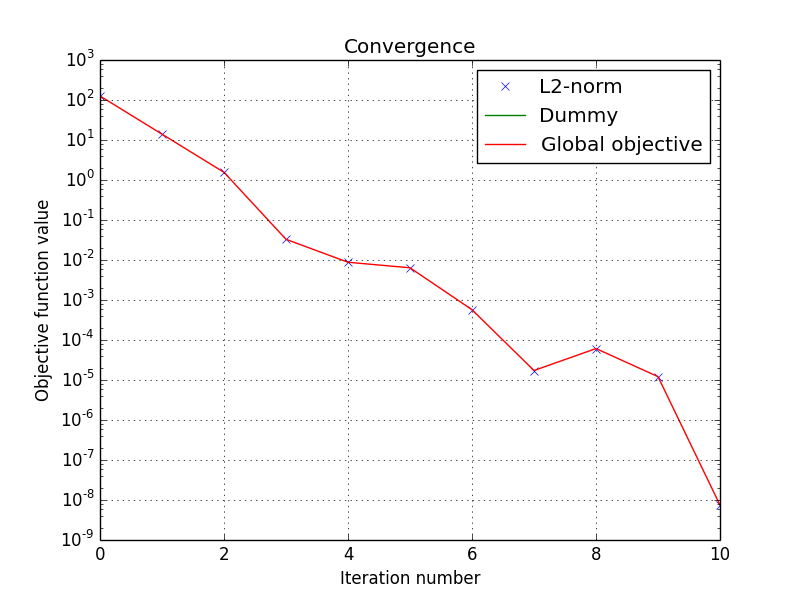Simple least square problem¶
This simplistic example is only meant to demonstrate the basic workflow of the toolbox. Here we want to solve a least square problem, i.e. we want the solution to converge to the original signal without any constraint. Lets define this signal by :
>>> y = [4, 5, 6, 7]
The first function to minimize is the sum of squared distances between the current signal x and the original y. For this purpose, we instantiate an L2-norm object :
>>> from pyunlocbox import functions
>>> f1 = functions.norm_l2(y=y)
This standard function object provides the eval(), grad() and
prox() methods that will be useful to the solver. We can evaluate them at
any given point :
>>> f1.eval([0, 0, 0, 0])
126
>>> f1.grad([0, 0, 0, 0])
array([ -8, -10, -12, -14])
>>> f1.prox([0, 0, 0, 0], 1)
array([ 2.66666667, 3.33333333, 4. , 4.66666667])
We need a second function to minimize, which usually describes a constraint. As
we have no constraint, we just define a dummy function object by hand. We have
to define the _eval() and _grad() methods as the solver we will use
requires it :
>>> f2 = functions.func()
>>> f2._eval = lambda x: 0
>>> f2._grad = lambda x: 0
Note
We could also have used the pyunlocbox.functions.dummy
function object.
We can now instantiate the solver object :
>>> from pyunlocbox import solvers
>>> solver = solvers.forward_backward()
And finally solve the problem :
>>> x0 = [0, 0, 0, 0]
>>> ret = solvers.solve([f2, f1], x0, solver, atol=1e-5, verbosity='HIGH')
func evaluation : 0.000000e+00
norm_l2 evaluation : 1.260000e+02
INFO: Forward-backward method : FISTA
Iteration 1 of forward_backward :
func evaluation : 0.000000e+00
norm_l2 evaluation : 1.400000e+01
objective = 1.40e+01, relative = 8.00e+00
Iteration 2 of forward_backward :
func evaluation : 0.000000e+00
norm_l2 evaluation : 1.555556e+00
objective = 1.56e+00, relative = 8.00e+00
Iteration 3 of forward_backward :
func evaluation : 0.000000e+00
norm_l2 evaluation : 3.293044e-02
objective = 3.29e-02, relative = 4.62e+01
Iteration 4 of forward_backward :
func evaluation : 0.000000e+00
norm_l2 evaluation : 8.780588e-03
objective = 8.78e-03, relative = 2.75e+00
Iteration 5 of forward_backward :
func evaluation : 0.000000e+00
norm_l2 evaluation : 6.391406e-03
objective = 6.39e-03, relative = 3.74e-01
Iteration 6 of forward_backward :
func evaluation : 0.000000e+00
norm_l2 evaluation : 5.713369e-04
objective = 5.71e-04, relative = 1.02e+01
Iteration 7 of forward_backward :
func evaluation : 0.000000e+00
norm_l2 evaluation : 1.726501e-05
objective = 1.73e-05, relative = 3.21e+01
Iteration 8 of forward_backward :
func evaluation : 0.000000e+00
norm_l2 evaluation : 6.109470e-05
objective = 6.11e-05, relative = 7.17e-01
Iteration 9 of forward_backward :
func evaluation : 0.000000e+00
norm_l2 evaluation : 1.212636e-05
objective = 1.21e-05, relative = 4.04e+00
Iteration 10 of forward_backward :
func evaluation : 0.000000e+00
norm_l2 evaluation : 7.460428e-09
objective = 7.46e-09, relative = 1.62e+03
Solution found after 10 iterations :
objective function f(sol) = 7.460428e-09
last relative objective improvement : 1.624424e+03
stopping criterion : ATOL
The solving function returns several values, one is the found solution :
>>> ret['sol']
array([ 3.99996922, 4.99996153, 5.99995383, 6.99994614])
Another one is the value returned by each function objects at each iteration.
As we passed two function objects (L2-norm and dummy), the objective is a 2
by 11 (10 iterations plus the evaluation at x0) ndarray. Lets plot a
convergence graph out of it :
>>> try:
... import numpy as np
... import matplotlib, sys
... cmd_backend = 'matplotlib.use("AGG")'
... _ = eval(cmd_backend) if 'matplotlib.pyplot' not in sys.modules else 0
... import matplotlib.pyplot as plt
... objective = np.array(ret['objective'])
... _ = plt.figure()
... _ = plt.semilogy(objective[:, 1], 'x', label='L2-norm')
... _ = plt.semilogy(objective[:, 0], label='Dummy')
... _ = plt.semilogy(np.sum(objective, axis=1), label='Global objective')
... _ = plt.grid(True)
... _ = plt.title('Convergence')
... _ = plt.legend(numpoints=1)
... _ = plt.xlabel('Iteration number')
... _ = plt.ylabel('Objective function value')
... _ = plt.savefig('doc/tutorials/simple_convergence.pdf')
... _ = plt.savefig('doc/tutorials/simple_convergence.png')
... except:
... pass
The below graph shows an exponential convergence of the objective function. The
global objective is obviously only composed of the L2-norm as the dummy
function object was defined to always evaluate to 0 (f2._eval = lambda x:
0).
